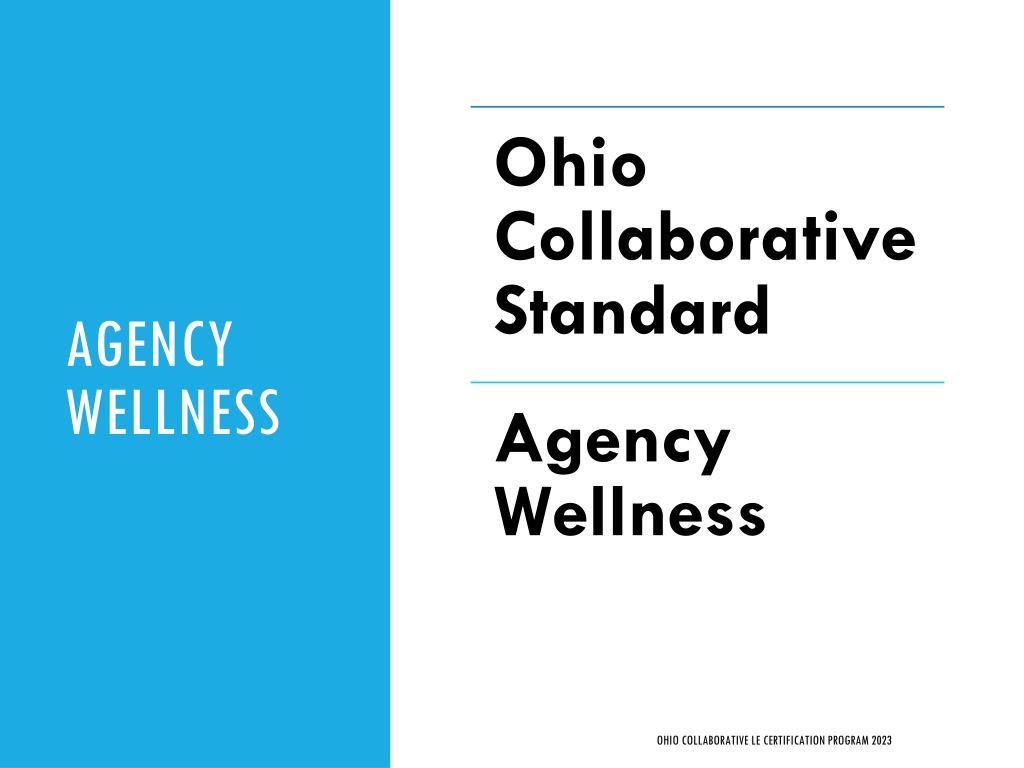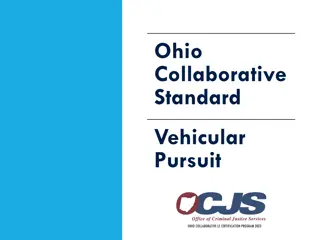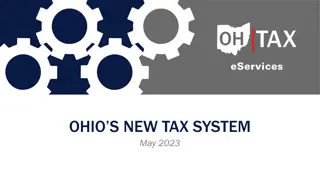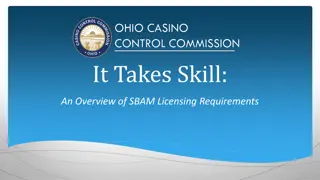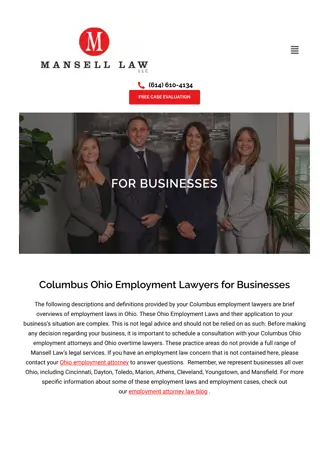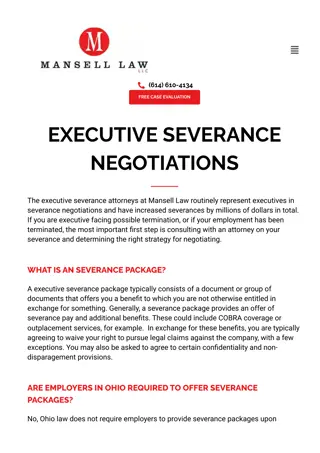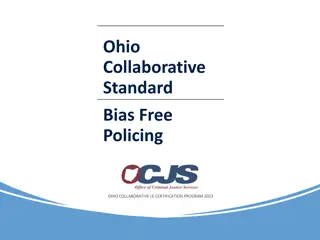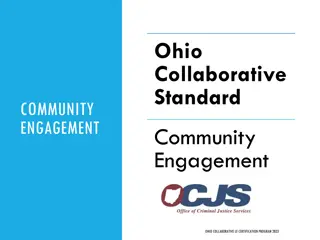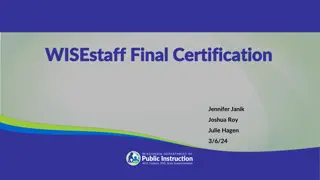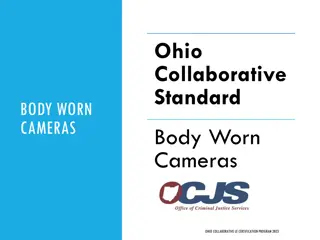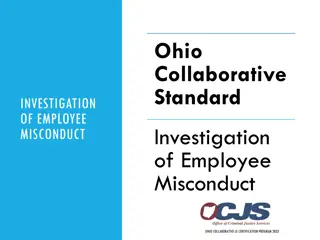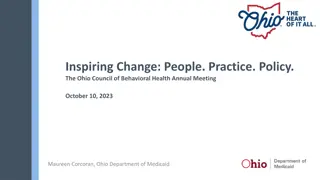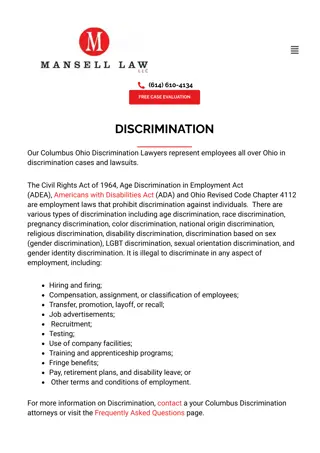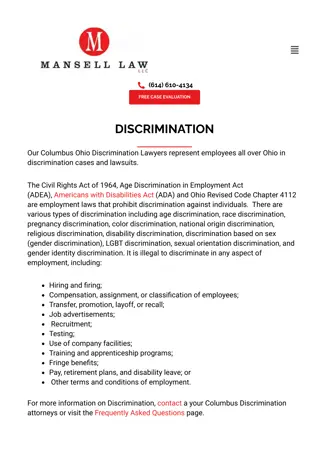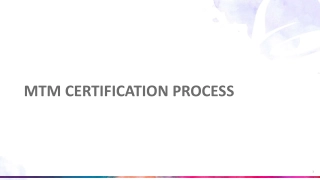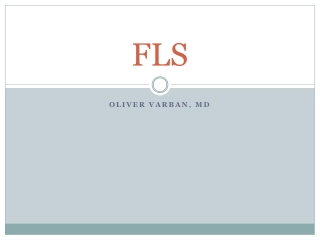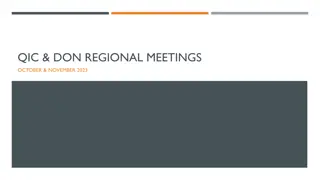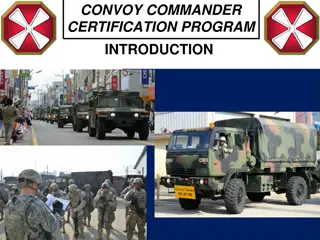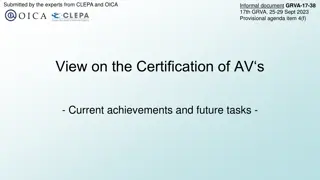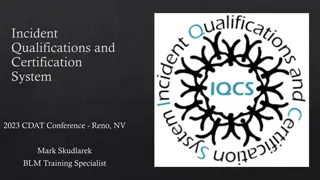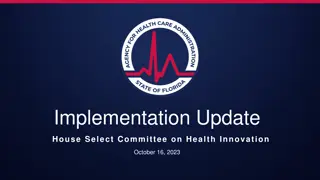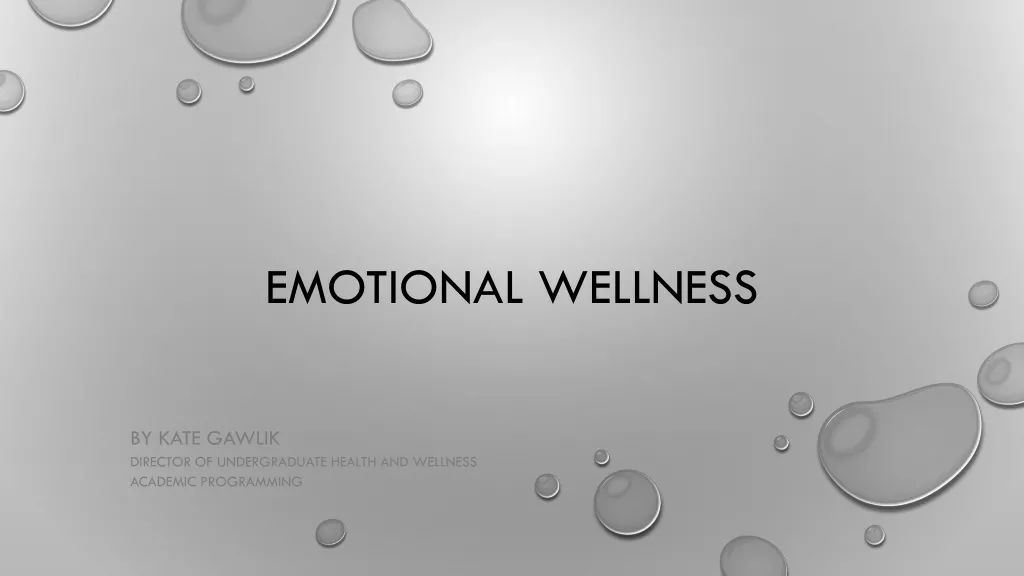Ohio Collaborative Agency Wellness Certification Program Overview
In 2021, the Ohio Collaborative Community-Police Advisory Board adopted the State of Ohio Standard for Agency Wellness to address the mental and physical health and safety of law enforcement personnel. The purpose is to mitigate the impact of poor health on officer performance and community relationships. The standards focus on education, access to resources, and support for officer wellness, including physical exercise, nutrition, mental health support, and peer assistance programs.
Ohio Collaborative Agency Wellness Certification Program Overview
PowerPoint presentation about 'Ohio Collaborative Agency Wellness Certification Program Overview'. This presentation describes the topic on In 2021, the Ohio Collaborative Community-Police Advisory Board adopted the State of Ohio Standard for Agency Wellness to address the mental and physical health and safety of law enforcement personnel. The purpose is to mitigate the impact of poor health on officer performance and community relationships. The standards focus on education, access to resources, and support for officer wellness, including physical exercise, nutrition, mental health support, and peer assistance programs.. Download this presentation absolutely free.
Presentation Transcript
Ohio Collaborative Standard AGENCY WELLNESS Agency Wellness OHIO COLLABORATIVE LE CERTIFICATION PROGRAM 2023
Learning Objectives Agency Wellness Standard: Purpose Standard LEARNING OBJECTIVES Commentary Model policy Compliance Summary/Recommendations OCJS Contact Information
21st Century Policing AGENCY WELLNESS 6.1 recommendation: The U.S. Department of Justice should enhance and further promote its multi-faceted officer safety and wellness initiative.
AGENCY WELLNESS In 2021, The Ohio Collaborative Community- Police Advisory Board adopted the State of Ohio Standard for Agency Wellness
Purpose: Law enforcement agencies have an obligation to ensure the mental and physical health and safety of their agency personnel. Officer wellness is not only an individual issue-it is also an agency issue and a public issue, as the negative consequences of poor mental and physical health can impact officer performance and affect community relationships. Law enforcement agencies are uniquely situated to address issues of officer stress and trauma, to reduce the stigma of seeking help and to create an environment of support. AGENCY WELLNESS
AGENCY WELLNESS Standard Law enforcement agencies shall establish a written policy specifically focused on the physical and mental wellness of agency personnel. The policy shall address the following areas: Education of officers and executive-level staff on issues of physical health, including the importance of exercise and nutrition as a way of reducing stress and improving overall health outcomes.
AGENCY WELLNESS Standard continued Access to multiple resources for mental and physical support to officers and their families, such as: 1. Employee Assistance Program resources, such as in-house and/or external clinicians, and other wellness staff who have knowledge of the law enforcement experience. 2. Peer support teams to augment (not replace) EAPs or in- house/external clinicians. 3. Agency chaplains. 4. Non-clinical interventions that promote mental and physical well- being, such as physical exercise, dietary guidance and sleep hygiene.
Awareness of organizational factors that can impact an officer s mental and physical health on a daily basis. Organizational climate and management techniques should be perceived by officers as fair, transparent, and supportive. Supportive supervision includes encouraging health and wellness through policies, practices, and programming, empowering formal and/or informal peer support, and providing quality leadership and supervision. AGENCY WELLNESS
AGENCY WELLNESS Standard continued An annual review of this policy, and an assessment of the effectiveness of the agency s wellness programs, with adjustments as needed based on feedback and/or other outcomes.
AGENCY WELLNESS Commentary Healthy officers create healthy agencies. The mental and physical health and welfare of officers is often overlooked, yet it is a vital consideration, not only to the officer, but also to the officer s family and loved ones, to the agency in which the officer is employed, and even to the community in which the officer lives and works. Investing in officer wellness is a significant step that agencies can take to positively impact their officers overall well-being and, as a result, to improve the community s trust and perceptions of legitimacy in the organization.
AGENCY WELLNESS Commentary continued Officer mental health is usually discussed in terms of the impact of critical incidents that may have short or long-term consequences on an officer. Research has documented the relationships among exposure to traumatic events and resulting physical or behavioral health disorders. While the inclusion of a Critical Incident Stress Management (CISM) policy is beyond the scope of an officer wellness policy, agencies should strongly consider developing a stand-alone CISM policy or procedures, to include defining what constitutes a critical incident, identifying all involved and affected employees, and detailing all post-incident administrative procedures.
AGENCY WELLNESS Commentary continued Despite the potential for critical incidents to have a significant impact on officers, officers encounter such situations relatively infrequently. In contrast, chronic stressors can be just as, if not more, damaging to an officer than a single traumatic incident. Studies show the connection between the daily stressors of police work and physical & psychological ailments. Officers often bear witness to the pain of those victimized and are present in the moments soon after a dangerous and traumatic event. Research also demonstrates the strong association between chronic stress and organizational climate.
AGENCY WELLNESS Commentary continued When officers perceive their organization to be procedurally fair thus allowing for effective and open communication, involvement in decision-making, and equitable treatment they are less likely to be psychologically and emotionally distressed, resulting in greater officer well-being. Left untreated, stress regardless of its source significantly increases the risk of mental and substance use disorders and chronic physical diseases. Thus, a policy on officer wellness needs to comprehensively consider the impacts of critical incident trauma, chronic exposure to traumatic events, and chronic exposure to organizational stress.
Commentary continued Traditionally, law enforcement agencies have taken a reactive approach to officer wellness. In short, they have viewed it as largely an individual responsibility to seek clinical intervention or develop coping mechanisms resources which may or may not be provided by the agency to mitigate the already-existing symptoms and effects of stress. While these tools are important components to a comprehensive approach to addressing officer wellness, it is ultimately more beneficial for law enforcement agencies to take a proactive approach to wellness and to address the root causes of officer stress. A well-rounded policy on officer wellness must address both the causes of, and the responses to, officer stress. Additionally, prior to retirement, agencies should make available wellness resources to help an officer prepare, as the transition for those who separate or retire from active duty can be difficult. If feasible, agencies should consider extending resources for a period of time after separation. AGENCY WELLNESS
Commentary continued Finally, law enforcement agencies must consider the lens in which they view officer wellness, particularly mental health wellness. Officers play the role of being the helpers, not looking to others for help. One of the primary barriers to officers seeking help is the stigma associated with needing such treatment. Executives must acknowledge agency's investment in the mental health of its officers. There must be a cultural shift at the executive, supervisory, and peer levels that encourages and supports officers to seek assistance and to provide assistance when needed. Regularly- occurring communication with officers about mental health signs and symptoms, wellness strategies, and available resources will de- stigmatize mental health discussions and reinforce the agency s commitment to their employees overall health and wellbeing. AGENCY WELLNESS
AGENCY WELLNESS Model Policy It is the policy of this law enforcement agency to provide all personnel with access to mental health services to help them preempt and resolve emotional difficulties and to take those measures necessary in the provision of mental health services to ensure their wellness and safety. It is also the policy of this agency to take immediate action after traumatic incidents to safeguard the continued mental wellness of all involved personnel. Further, agencies have a duty to be aware of and provide resources relating to officers physical health, including cardiac health, sleep deprivation, physical fitness and maintenance of a healthy weight.
AGENCY WELLNESS Purpose: Law enforcement agencies have an obligation to ensure the mental and physical health and safety of their agency personnel. Wellness is not only an individual issue-- it is also an agency issue and a public issue, as the negative consequences of poor mental and physical health can impact officer performance and affect community relationships. Law enforcement agencies are uniquely situated to address issues of employee stress and trauma, to reduce the stigma of seeking help and to create an environment of support.
AGENCY WELLNESS DEFINITIONS Acute Stress Disorder: An intense reaction (cognitive, emotional, and/or behavioral) to trauma within a month after a traumatic event. Chaplain: A member of the clergy who serves in a nondenominational capacity to aid employees in their spiritual health as well as other aspects of health and wellness. Early Identification System (EIS): A system designed to assist supervisors and managers in identifying employees whose performance warrants review and, where appropriate, outline intervention procedures in circumstances where the employee s behavior may have negative consequences for the employee, coworkers, the agency, and/or the general public. Employee Assistance Program (EAP): Confidential mental health services provided by a third party and sponsored by the employer.
AGENCY WELLNESS Family Orientation: An opportunity for family members to tour agency facilities, including the communications center; meet the chief executives, chaplains, and peer support team; and learn about available support services, including those related to mental health. Impacted Personnel: Any employee who is identified as being affected by a traumatic incident. This may include employees who are on the scene at the time of the incident, individuals who respond to the scene immediately following the incident, and/or support personnel participating in the response to the incident, such as communications personnel. Mental Health Services: Services provided by an agency-employed and/or agency- contracted qualified mental health professional. Mental Health Wellness Consultation: An opportunity for employees to meet with a qualified mental health professional of their choice for a confidential mental health discussion.
Peer Support: A program designed to provide one- on-one emotional, social, or practical support and referrals to additional professional services, when needed. The program comprises specifically trained sworn or civilian colleagues, referred to as peer support persons, who are not counselors or therapists. AGENCY WELLNESS Peer Support Team Members: A formal group of individuals consisting of agency members who have undergone training in peer support methods. Post-traumatic Stress Disorder (PTSD): An intense and persistent reaction to trauma including intrusive thoughts, avoidance behaviors, negative thoughts and feelings, and/or arousal and reactive symptoms that disrupts one s normal functional ability.
Psychological Services/Behavioral Health and Wellness Program: Confidential mental health services provided outside of insurance by a private company with culturally competent mental health professionals. Qualified Mental Health Professional (QMHP): An individual who is licensed as a mental health professional and has an in-depth understanding of trauma- related disorders and the law enforcement culture. AGENCY WELLNESS Resiliency: The capacity to prepare for, recover from, adapt to, and navigate through stress and adversity, to include applying skills to everyday life to strengthen one s ability to overcome challenges, maintain peak performance, and thrive personally and professionally. Traumatic Incident: An incident that may overwhelm an individual s normal coping mechanisms and cause extreme psychological distress.
PROCEDURES General Employee Mental Health and Wellness Agencies should develop policies and programs aimed at promoting employee mental health and wellness. Considerations may include the following: Identifying, vetting, and enlisting QMHPs. This should include determining whether the QMHP is trained in traumatic incident response and is prepared to provide stress management for a number of employees at one time. Making confidential mental health services available to all employees of the agency and their families as allowed by insurance coverage or agency policy. AGENCY WELLNESS
AGENCY WELLNESS Determining whether employees should participate in a periodic, confidential mental health and wellness consultation with a QMHP. Providing EAPs, psychological services, and behavioral health and wellness programs to all agency employees and their families. Conducting family orientations. Orientations should incorporate these attributes: Be organized by the agency and be provided at minimum to new employees and their families; Be conducted by the agency s employees and a panel of law enforcement family members; and Include information regarding agency EAPs, psychological services, behavioral health and wellness programs, insurance, peer support, and other supportive programs.
AGENCY WELLNESS Providing peer support. This may include the following: Establishing a peer support program. Selecting peer support persons (PSPs) from experienced personnel who have earned the respect and confidence of their fellow employees. Ensuring PSPs demonstrate excellent active listening and interpersonal skills. Removing PSPs from the program for violating the program s confidentiality policy and/or engaging in other behavior that is considered detrimental to the program. Training PSPs on an initial and ongoing basis to provide both day-to-day emotional support for agency employees, as well as participating in the agency s comprehensive response to traumatic incidents. Ensuring the peer support program is supervised by a senior agency employee and works in conjunction with a QMHP familiar with peer support operations. Addressing limits to confidentiality and privileged communications.
AGENCY WELLNESS Providing Identifying Implementing Providing peer intervention training to all employees. Identifying chaplains for those employees who may prefer an alternative avenue for communication. Depending on the licensing or credentials of the chaplain, this contact could replace contact with a QMHP. Implementing an EIS to aid in the proactive identification of employee wellness concerns.
Offering ongoing in-service training and education to agency employees to promote mental health and overall wellness, to include training related to resiliency, mindfulness, and retirement planning. Offering AGENCY WELLNESS Developing an informational program for family/relationship members concerning available support and counseling services. Developing Working with other agencies to identify and access mental health resources. Working
Mental Health Following a Traumatic Incident Agencies should also consider developing guidelines for supporting wellness when traumatic incidents occur. Guidelines may include: AGENCY WELLNESS Preparation When developing policies and procedures related to mental health following a traumatic incident, agencies should consider: Training for officers, non-sworn personnel, and all supervisors to identify and manage stress related to traumatic incidents; The potential costs of a traumatic incident and psychological response and who will be responsible for assuming them; Training simulations that bring together potential participants of responding resources.
Mental Health Following a Traumatic Incident continued Immediate Response Immediately following a traumatic incident, agencies should consider: a.Providing proper mental health resources to impacted personnel who may experience physical, cognitive, emotional, and/or behavioral reactions to the incident; AGENCY WELLNESS b.Developing guidance on how to interact with impacted personnel, which may include requesting that others recognize the potential stress caused by the incident and refrain from passing judgment regarding the traumatic incident or the reactions of individuals; c.Appropriate supervisory response, to include discussing standard investigative protocols that will be followed concerning the incident.
Mental Health Following a Traumatic Incident continued Post-Incident Procedures To ensure that involved personnel are treated appropriately following a traumatic incident, agency policy should address the following items: AGENCY WELLNESS a.Contacting a previously identified QMHP who specialized in traumatic incident response as soon as possible in order to determine the best approach for all involved personnel. The policy should designate who is responsible for this notification. The QMHP should be briefed by an individual such as the on-site supervisor or incident commander, where appropriate, on all important and relevant aspects of the traumatic incident.
AGENCY WELLNESS Determining the appropriate psychological tools to be utilized. Agencies must determine whether participation in post-event mental health follow-up is required and whether they must be in person. Guidelines should be established regarding the information that the QMHP releases to the agency. This may include: Whether it would be in the best interest of certain individuals to have time off work, and/or the best continued course of counseling and intervention Post-Incident Procedures continued
Mental Health Following a Traumatic Incident continued Post-Incident Procedures continued Agencies must determine what information will be provided to impacted personnel prior to the use of psychological tools, such as whether or not the information shared: Is considered privileged or confidential; AGENCY WELLNESS Will be communicated back to the agency; Will potentially affect their fitness-for-duty; Could impact the investigation of the event, or the rights of accused or others in future criminal or civil litigation; Will impact return-to-work status recommendations.
Accessing follow-up counseling services. This may include assisting employees or families of impacted personnel to contact available counseling or support services. Investigation Agencies should address procedures for investigating a traumatic incident, where applicable, in separate policies and procedures. Agencies should consider: AGENCY WELLNESS a.Stressing that the investigation should be conducted as soon as practical, and every effort should be made to expedite the completion of any administrative or criminal investigation with the goal of decreasing the negative stress reactions that involved personnel may experience; b.Assigning a liaison between the investigation and those involved personnel.
AGENCY WELLNESS Mental Health Following a Traumatic Incident continued Stress Recognition in the Aftermath of a Traumatic Incident Physical, cognitive, emotional, and behavioral reactions or problems might not arise immediately. In addition, involved personnel may attempt to hide their negative responses to the traumatic incident. Therefore, agency policy should: a.Encourage awareness and identification of potential negative responses in others by coworkers, supervisors, and PSP; b.Provide guidance regarding potential responses when these reactions or symptoms are identified, such as contacting a supervisor or PSP and/or mandating that the individual seek assistance or counseling from a QMHP; c.Recognize that effects of trauma are cumulative; d.Recognize that inadvertent re-traumatization can occur from implementing standard organizational policies, procedures, and interventions with individuals who have experienced trauma.
Training When developing a mental health and wellness training program, agencies should consider: AGENCY WELLNESS Ensuring training is accredited and routinely evaluated. Deciding who will receive the training. Ideally, this should be all personnel. Determining when training should be provided, such as during the academy, as well as during regularly scheduled in-service training. Establishing whether specialized training for supervisors and administrators will be provided. This may include training regarding identifying physical, cognitive, emotional, and behavioral reactions to traumatic incidents.
Delivering training on topics, such as: Suicide prevention Resiliency AGENCY WELLNESS Retirement planning Potential limits to confidentiality Peer intervention Availability of resources, such as the agency s peer support team, chaplains, EAP, psychological services, behavioral health and wellness programs, and employee wellness programs. This should also include resources available to families. Providing specific training related to mental health following a traumatic incident.
Providing pre-incident training that may include items such as: The negative physical, cognitive, emotional, and behavioral reactions that may occur following a traumatic incident, AGENCY WELLNESS Signs and symptoms that a fellow employee may be struggling with post-traumatic effects of a traumatic incident, The agency s policy on appropriate response to involved personnel following a traumatic incident. Annual Review: An administrative review of this policy, and an assessment of the effectiveness of the agency s wellness programs, with adjustments as needed based on feedback and/or other outcomes, shall be conducted annually.
Ohio Collaborative Wellness Standard Required Annual Compliance: AGENCY WELLNESS Current year training records (bullet B) Annual review (bullet D)
Ohio Collaborative Annual Standard Review The intent of any Ohio Collaborative Annual Review is to: Review policy and reporting procedures to determine if agency needs are being met; AGENCY WELLNESS Review patterns and trends with any data (feedback and other outcomes) collected; Review training needs, if any; Review equipment needs, if any. This information is crucial in assisting the CEO and command staff with making informed decisions for agencies. Each agency has unique challenges and circumstances in providing their citizens with the best service possible. Ensure your agency is using this template, and any other information gathering deemed necessary by the agency, to ascertain best results.
Summary/Recommendations AGENCY WELLNESS Healthy employees create healthy agencies Officer mental health is very often focused on response to a major or critical incident Often it s not the one incident that most effects personnel, it s the years of one incidents that take the greatest toll
Summary/Recommendations: AGENCY WELLNESS Studies show the connection between the daily stressors of police work and physical and psychological ailments. Employees often bear witness to the pain of those victimized and are present in the moments soon after a dangerous and traumatic event.
Research also demonstrates the strong association between chronic stress and organizational climate Summary/Recommendations: AGENCY WELLNESS Traditionally, law enforcement agencies have taken a reactive approach to agency wellness A well-rounded policy on agency wellness must address both the causes of, and the responses to, employee stress
Summary/Recommendations: AGENCY WELLNESS Prior to retirement, agencies should make available wellness resources to help employees prepare, as the transition for those who separate or retire from active duty can be difficult Agencies should consider extending resources for a period of time after separation
Summary/Recommendations: AGENCY WELLNESS Finally, law enforcement agencies must consider the lens in which they view wellness, particularly mental health wellness There must be a cultural shift at the executive, supervisory, and peer levels that encourages and supports employees to seek assistance and to provide assistance when needed
AGENCY WELLNESS Summary/Recommendations: Partner with local mental health providers and organizations for assistance with the public and agency personnel Mental wellness needs to be part of an agency s culture, the chief executive through all levels of personnel Mental and physical wellness are inseparable and both contribute to the other
AGENCY WELLNESS Any agency wellness plan must include all levels of leadership in order to be successful Don t forget communications personnel Summary/Recommendations: Take advantage of local mental health resources Take advantage of state offered programs Wellness MUST be a priority of the entire agency
AGENCY WELLNESS Contact Information Steven M. Click, Director Ohio Office of First Responder Wellness Office Criminal Justice Services 1970 West Broad Street Columbus, Ohio 43233 614-466-4470 Desk 614-949-2428 Cell STClick@dps.ohio.gov
